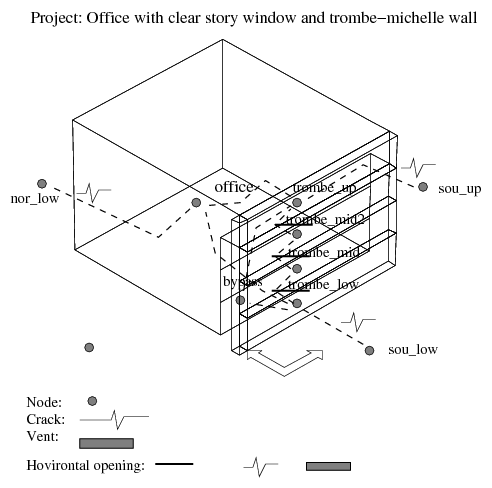Interzone air flow
In ESP-r air movement between rooms is termed ventilation whether it is scheduled or calculated as part of a flow network or CFD domain. Each of these methods feeds into a common data structure and bookkeepping for mass transfer used in the zone energy balance. In general scheduled ventilation flows are specified as air changes or in M^3/s from a source zone, a static temperature source or from ambient. Although only two ventilation sources that can be scheduled in a zone, there are no such limits when included in a flow network.
Mixing between zones
Mixing between core and perimeter zones can be scheduled by entering a volume flow rate in each of the zones bounding the opening. This is a crude abstraction. A better approach is to use a bi-directional flow component within a flow network (usually providing a constrained discharge factor).
Mixing between atria and adjacent offices is most often represented within a flow network where the atria volume is sub-divided so that multiple temperatures can be tracked. Bi-directional flow components can be used for horizontal flows and orifices for vertical exchanges. Lastly, a CFD domain could be placed in the atria with mass flow connections to the adjacent rooms.
The Trombe-Michelle wall model in the figure below shows an approach to circulation within front space with vent connections to the occupied space. Note the small bypass zone (and flow node) which connects the top slice of the space with the bottom slice of the space. When the vents are closed circulation is still possible within the front space.

Mixing between reception areas and vestibules should be possible via a flow network but there is no explicit flow component for air curtains. For rapid door openings a short timestep and rather a lot of control periods might be needed.
Mixing or stratification within zones
Stratification within zones is a challenge for flow networks as there is no explicit bi-directional flow component for vertical separations. Sub-division of rooms and inclusion of a bypass flow path between the top and bottom can help with buoyancy flows. Stratification is best represented via a CFD domain. Heat sources in the room (i.e. casual gains) can be associated with cells in the domain and flows via windows or grills can also be included.
Vertical mixing within a stairwell could be treated as scheduled ventilation if the user had strong opinions. A flow network could be designed in conjunction with subdivision of the stairwell would provide a better approximation. Treatment as a CFD domain might be possible but would be rather tedious to setup.
Heat recovered from high level stratification could be represented as a simple fan component taking air from one zone to another location assuming the room was represented as several zones. A CFD domain in conjunction with a constant volume flow component and paths in a flow network would be a better approach.
Back to top | Back to Welcome page